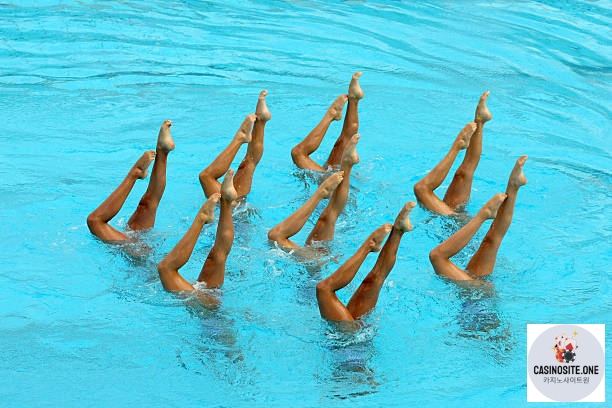
Synchronized Swimmers legs point up out of the water in actio
Synchronized swimming, now known as artistic swimming, is a water-based sport that combines elements of swimming, dance, gymnastics, and theater. It is usually performed by a team of swimmers, although there are also duet and solo events. The athletes, often called synchronized swimmers, perform a choreographed routine set to music while in the water.
Synchronized Swimming, also called Artistic Swimming, is a water sport where athletes perform synchronized dance routines to background music, while they are floating in water. The objective of the sport is to ensure all members of the team make the exact same movements which also flawlessly blend with the music, without their legs ever touching the floor.
The first synchronized swimming competitions took place in Berlin in 1891 and London in 1892. Contests were originally solely for men but it was soon recognized that artistic swimming was better fitted to women who were overall more buoyant, in particular in the legs. The major influence on pushing synchronized swimming to be recognized as a sport came from Canada.
Synchronized swimming is a water ballet. Choreographed movements in the water that must be performed. It combines swimming ability, flexibility, strength and creativity.
Synchronized Swimmers do not touch the bottom of the pool. During the performance, while swimmers are completing gravity-defying moves, they are not touching the bottom of the pool. They practice and compete in at least 9 feet of water or deeper. They do all of this while lifting each other up as well.
Swimmers commonly hold their breath underwater for around a minute, but sometimes between two to three minutes.
Therefore, synchronized swimming is dangerous whether in the pool or not. The kick of the head is so serious for all the swimmers because it gave a head trauma. And also you can wear proper equipment or gear to protect yourself.
Key features of synchronized swimming include:
- Synchronization: As the name suggests, one of the primary elements of the sport is the precise synchronization of movements among the swimmers. The team strives to perform their routines in perfect harmony, creating visually captivating patterns and formations.
- Flexibility and Artistry: Synchronized swimming emphasizes flexibility, grace, and artistic expression. Swimmers perform various acrobatic movements, such as flips, twists, and lifts, often with one another, to create visually stunning performances.
- Eggbeater Kick: Synchronized swimmers use a specific type of kick called the “eggbeater kick” to maintain an upright position in the water, allowing them to perform movements with their upper body while keeping their lower body stable.
- Technical and Free Routines: Competitions typically consist of two types of routines: technical and free. The technical routine involves a set of predetermined elements and movements that all teams must include in their performance. The free routine, on the other hand, allows teams to showcase their creativity and originality in designing their choreography.
- Competitions: Synchronized swimming is an Olympic sport and is also contested at various levels, including national and international competitions. Scoring is based on factors like execution, synchronization, difficulty, and artistic impression.
- Underwater Choreography: Synchronized swimmers often perform movements underwater, which requires precise breath control and exceptional swimming skills.
- Teamwork and Trust: Success in synchronized swimming heavily relies on strong teamwork, trust, and communication among the swimmers. They must work together seamlessly to execute complex routines flawlessly.
Artistic swimming demands significant physical conditioning, strength, and endurance from its athletes. It is a visually captivating sport that showcases the combination of athleticism and artistry in a unique water-based performance.


